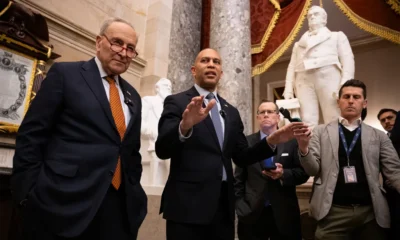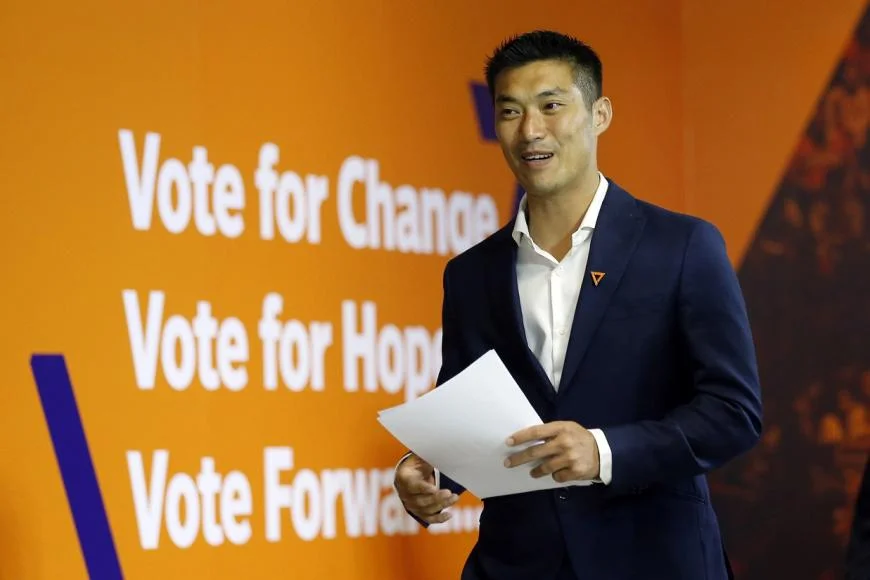Politics
The Democrats Now the Party of White Voters with College Degrees

WASHINGTON, DC – In the wake of the 2024 presidential race, the Democrats are confronting an unfamiliar reflection. The party that once rallied America’s broad working class, the same one that drove Franklin D. Roosevelt’s New Deal and powered Barack Obama’s rise, now looks anchored to white voters with college degrees.
Exit polls and post-election studies show a clear pattern. Kamala Harris, the first woman, the first Black woman, and the first person of South Asian heritage to head a major-party ticket, drew strong backing from suburban professionals with advanced degrees.
At the same time, she lost ground with the very groups that long formed the party’s core: Hispanics, Asians, Black voters, and the working and middle classes. Analysts argue this shift did not happen overnight. It reflects years of favouring the look of diversity over the habit of listening to the people that diversity represents.
The data point to a quiet crisis. A detailed Pew Research Center study of validated voters found Harris won college-educated voters by 16 points. That group is now about 40 percent of the electorate, and it skews white and affluent. Among white voters with a bachelor’s degree, Democratic identification sits at 51 percent, an even divide that marks a sharp change from the early 2000s, when non-college whites leaned heavily Democratic.
NPR’s Domenico Montanaro called this the “diploma divide,” now the main fault line in American politics. Educated white voters favour Democrats on climate and social issues, while voters with fewer credentials, across races, move to Republicans who push pocketbook themes.
In states like Georgia and Pennsylvania, white college graduates gave Harris her best margins, often by double digits. The party’s message plays well in office parks and tech corridors, but it struggles in factories and corner stores.
The gains with highly educated voters come with a heavy price. Non-college voters, who make up 57 percent of the electorate, up from near parity in 2016, backed Donald J. Trump by 14 points. That share includes a growing number of working-class minorities. Ruy Teixeira of the Brookings Institution, a veteran Democratic analyst, warns that this slide threatens the party’s long-term strength.
The working class, defined here by education as well as income, feels sidelined by a platform tuned to elite tastes. In a 2023 essay, Teixeira argued Democrats are becoming a party of the cognitive elite, a shift that leaves the coalition smaller, more rigid, and out of step with the math of winning elections.
Old Strongholds Erode: Hispanics, Asians, and Black Voters Pull Away
The breakdown is sharpest among racial and ethnic minorities who once formed a reliable Democratic base. Hispanic voters, the fastest-growing bloc in the electorate, hit Harris’s campaign hard. Trump won nearly half of them, 48 percent, up from 36 percent in 2020. That 12-point jump turned a Democratic stronghold into a contested space.
In Nevada and Arizona, where Latinos make up roughly a quarter of the population, Trump’s gains among non-college Hispanics proved decisive. Many cited rising prices, border policy, and a feeling that Democratic plans favoured newcomers over long-settled families. A Vox post-election review called it a credibility gap on the economy. Latino households, squeezed by post-pandemic inflation, saw the Biden-Harris agenda as heavy on symbolism and light on relief.
Asian voters also moved in larger numbers than expected. Harris’s margin among Asian American and Pacific Islander voters fell to 17 points, down from Biden’s 40-point win. Trump carried key Asian subgroups by double digits in swing states like Georgia. Gallup’s long-term trend shows the Democratic edge with Asians at its lowest since the 1960s.
Parents point to school closures, public safety, and policies such as affirmative action that many saw as unfair to high-achieving Asian students. In New York City, support for Trump climbed to 30 percent in heavily immigrant areas, according to New Lines Magazine, where residents pushed back on outreach that felt patronizing.
Even Black voters, the party’s most loyal group, showed slippage. Harris still won 83 percent, down 4 points from Biden, but Trump doubled his share to 15 percent. Among Black men under 50, defections reached about 21 percent in some surveys. The Guardian had flagged this trend before the election.
Identification with Democrats among non-Hispanic Black voters fell to historic lows, driven by economic stress and cultural friction. A Brookings review after the election cited a mismatch with working-class needs. Black women faced higher unemployment at 6.2 percent, compared with 4 percent for white women. Targeted appeals failed to address broader economic interests.
Losses with minority voters, layered over setbacks with the working and middle classes, left Democrats with a coalition rich in donor money but light on votes. Union leaders, once central allies, now call for a “reconstruction” of the party, as reported by NBC News.
They argue the long slide in blue-collar support reached a breaking point in 2024. In Macomb County, Michigan, a bellwether once known for Reagan Democrats that later backed Trump, non-college voters across races moved 20 points to the right. PBS News Weekend described that shift as the class revolt driving the election.
The Risk of Performative Diversity: Symbolism Without Connection
At the core of this setback sits a charge that has lingered for years and erupted in 2024. Democrats focused on looking diverse, while failing to hear the diverse voices they champion. The party’s embrace of diversity, equity, and inclusion started as a moral cause.
Over time, critics say it turned into a performance that prized checklists over skill and symbols over results. Heather Mac Donald of the Manhattan Institute argued in Newsweek that this posture made the party less diverse, pushing away the very groups it hoped to help by swapping identity for merit.
The 2020 primaries offered an early preview. After the George Floyd protests, Democrats presented a field rich in candidates of colour and women. CBS News found voters eager for “women and people of colour.” Yet the race narrowed to Joe Biden and Bernie Sanders, two white men, a shift shaped by rules and donor systems that favoured insiders over challengers.
By 2024, the reckoning arrived. Harris’s role on the ticket, hailed as historic despite a lacklustre 2020 primary run, became the flashpoint. Coverage from The New York Times and CNN framed her ascent as a milestone. Many working-class minority voters saw a candidate elevated for identity, not for a record on the issues that drive daily life.
The identity-first approach reached down the ballot. In many contests, the push for representative slates produced candidates with compelling biographies but thin policy records. Frederick Hess of the American Enterprise Institute labelled this the Democrats’ merit problem. He argued DEI targets displaced tough vetting for staffers, judicial picks, and even convention delegates.
POLITICO reported worries about delegate quotas ahead of the convention, such as California’s 43 percent Hispanic goal. Veterans said they were passed over for symbolic selections. Ruy Teixeira, writing in The Liberal Patriot, warned that sidelining merit seeped into hiring on campuses and into policy debates, weakening trust among voters who want competence over confessionals.
The irony is hard to miss. In elevating representation, Democrats lost touch with the everyday concerns that cut across lines. Paychecks lag behind prices. Schools feel stuck in cultural fights. The border strains under migration. Axios found the party’s edge among Black, Hispanic, and Asian voters at a 60-year low. Many did not see prejudice as the main factor.
They saw box-checking. Large shares of Hispanic voters rejected the term “Latinx,” according to Equis Research. Many Asian parents saw DEI training as elite talk, while they pushed for admissions based on achievement. A post-election review by Good Authority described a sharper sorting. College-educated voters leaned liberal, while non-college voters leaned conservative. Working-class Latino and Black voters felt Democratic policies did not meet their daily needs.
The Cost of Identity Over Merit, and a Way Forward
The 2024 results delivered a clear verdict. Harris’s loss was not only about turnout. Pew’s validated data shows nonvoters leaned toward Trump by 4 points. The larger hit came from persuasion. Working-class voters and many minorities did not accept the pitch.
Trump’s coalition mixed white voters without degrees with rising shares of Hispanics, 46 percent in NBC’s exit polls, and more Black men, 21 percent. He pressed pocketbook issues that Democrats often treated as secondary. The Hill warned that shrinking support could even sap white liberals’ commitment to progressive causes, as the party’s base narrows to a coastal circle.
Democrats are now debating their next move. Union leaders want a return to class-based politics. Strategists like Carlos Odio of Equis advise dropping “woke” jargon and returning to bread-and-butter themes.
Yet, as The New York Times reported in February 2025, the party is struggling to defend DEI against Trump’s attacks while staying true to its values. At a Stanford Freeman Spogli Institute forum on “Diversity and Democracy,” speakers pressed a simple idea. Real multiracial progress requires listening. Merit and identity should stand together. That is the route to rebuild a broad coalition.
The 2024 setback was not a rejection of diversity itself. It was a rejection of its hollow version. In rushing to showcase a rainbow, the party lost the work of building trust across lines of class and culture. Heading toward 2028, the question is urgent. Can Democrats return to a coalition shaped by kitchen-table concerns, or will they stay bound to the tastes of the academy? For a party born in union halls and civil rights marches, the stakes could not be higher.
Related News:
The Democrats’ Great Betrayal, Champions of the Working Man to Handmaids of the Elite
Politics
Trump’s “Core 5” Alliance Leaked Plan Outlines Bold Strategy To Avoid World War III
Promethean Action Paper Proposes New Security System That Puts Sovereignty Above Old Alliances

WASHINGTON D.C. – The international political landscape has been rocked by the leak of a classified document outlining an extraordinary and radical new foreign policy strategy from the Trump Administration. Trump’s plan, dubbed the “Revolutionary Alliance,” reportedly seeks to dismantle the post-World War II global architecture—including institutions like the G7 and, controversially, the NATO alliance—to establish a new “Core 5” council of major world powers.
The paper, which looks and reads like a high-level administration strategy document (although the White House has not commented), calls for a deep reset of American foreign policy. It urges the United States to move away from large, treaty-based alliances built after the Second World War. In their place, it proposes a tighter, deal-focused system built around five central principles, which it calls the “Core 5”.
Promethean Action’s Worldview
Promethean Action is not an official arm of the White House, but analysts have long linked its ideas to the current administration. Commentators often describe the group’s outlook as “neo-sovereigntist”. It strongly backs absolute national independence and treats open-ended mutual defence treaties as a dangerous limit on national choice.
The Core 5 plan is framed as a break from both old alliances and classic isolationism. It argues that the United States should pull back from conflicts where its direct interests are not clearly involved. By doing so, it seeks to lower the risk of mistakes or local clashes growing into a global war.
The authors put forward a blunt claim: the very alliance systems created to stop world wars now increase that danger. By tying many states together, they say, regional disputes can turn into international crises when obligations are triggered.
The Five Pillars Of The “Core 5” Strategy
The leaked document rests on a set of major policy changes. Together, they aim to build a new balance of power based on clear, bilateral deals instead of wide, shared commitments. The five pillars are:
- Sovereignty-First Security Accords (S-FSA)
The paper calls for a full review, and possible cancellation, of current defence treaties, including NATO’s Article 5 and key Pacific agreements. In their place, the United States would sign time-limited, strictly reciprocal bilateral accords. Support under an S-FSA would be conditional and transactional. Two factors would shape any American military help: the partner’s direct financial contribution and its clear alignment with U.S. national interests. The approach treats security as a paid-for service and openly rejects the idea of automatic, collective defence. - The “Expeditious Stability” Doctrine
This doctrine offers a new way to handle wars such as the conflict in Eastern Europe. Instead of insisting on a full return to pre-war borders, it calls for a rapid halt to fighting and a quick peace deal, even if the weaker side must surrender territory. The main goal is to freeze conflicts and keep them from spiralling into clashes between nuclear powers. VORNews analysts argue that this may reflect President Trump’s still-unclear plan for a fast end to the war in Ukraine. - The New Technological Sphere (NTS) Coalition
The Core 5 plan proposes a tight club of states that would work together to secure and dominate advanced technologies like artificial intelligence, quantum computing, and high-end manufacturing. The framework names the United States, Israel, Japan, the United Kingdom, and India as the founding members of this “inner circle”. This coalition would apply tough export controls to rivals and create a technology barrier aimed at keeping long-term Western superiority. It would also limit the bargaining power of competitors such as China. - The “Trump Corollary” To The Monroe Doctrine
Echoing signals in the official National Security Strategy, the Promethean Action paper sets out what it calls a “Trump Corollary”. This policy claims absolute U.S. primacy in the Western Hemisphere. It expects all countries in the region to shape their security, trade, and border policies in line with U.S. interests. The document also warns that any hostile outside move into the hemisphere, economic or military, will trigger a firm unilateral American response. Supporters see this as a bid to lock in supply chains and energy flows, so that turmoil abroad cannot easily threaten the U.S. home front. - The “Managed De-Leveraging” Initiative
The fifth pillar is an ambitious economic project. It calls for a planned, multi-year effort to reduce U.S. economic dependence on major rivals, with a strong focus on China. Rather than rely on tariffs alone, it urges Washington to actively shift key manufacturing and pharmaceutical production back to the United States or to trusted S-FSA partners. The document claims that deep economic ties, once praised as a force for peace, now act as tools of pressure. It argues that real national security needs economic separation, so that hostile states cannot disrupt or control American industry.
Global Response: Fear, Doubt, And New Openings
The leak has caused deep concern among long-standing allies. European governments, already under pressure from Washington to boost their own defence spending, are likely to see the Sovereignty-First Security Accords as a direct blow to NATO’s 75-year-old foundation. The basic message is clear: the era of open-ended U.S. guarantees to collective defence is coming to an end.
At the same time, some countries may spot advantages. India, for example, is listed as a core player in the NTS Coalition. For New Delhi, that status might offer a way to work more closely with Washington without joining older Western clubs that carry heavy expectations.
Rival powers receive mixed signals from the plan. The “Expeditious Stability” Doctrine hints that the U.S. could accept less-than-perfect peace deals in current conflicts. Yet the hard line in the “Trump Corollary” and the closed nature of the NTS Coalition suggest sharper, more focused competition ahead.
High-Risk Strategy With Unclear Outcomes
The Promethean Action proposal represents a major gamble. By discarding much of the post-war security model, President Trump is staking his foreign policy on a simple idea: a world of firm borders and limited, interest-based alliances is less likely to slide into total war than a world of dense, mutual defence ties.
“The logic is terrifyingly simple,” said Dr Elias Vance, a senior fellow at the Center for Global Strategic Studies, in an interview with VORNews. “If you remove the tripwire, you remove the trigger. The President wants to swap collective defence for clear deterrence, stating that America will only fight for American interests. The danger is that this could open gaps in the system and tempt local aggression, because a joint response is no longer guaranteed.”
The administration has not formally adopted the Core 5 paper, but many of its themes already show up in recent policies and diplomatic talks. If carried out in full, the framework would mark the biggest change in U.S. foreign policy since the end of the Cold War. Supporters believe it could bring stable, separate spheres of influence. Critics warn that it might create a harsh world where each state stands alone.
VORNews will keep following the story, tracking both the authenticity of the leak and any steps toward putting this bold, and to some, reckless security vision into practice.
Related News:
Trump Calls European Leaders Weak, Warns Over Mass Migration
Politics
Trump Calls Ilhan Omar a Disgrace as Immigration Fraud Allegations Resurface

WASHINGTON D.C. – In a heated Oval Office clash that has dragged one of the Trump era’s most divisive sagas back into the spotlight, President Donald J. Trump on Friday branded Minnesota Democrat Rep. Ilhan Omar a “disgrace” who does not deserve public attention, bluntly declaring, “I don’t want to hear from Ilhan Omar, not one word.”
His attack came as long-running accusations against the congresswoman reappeared in the headlines. Critics again claim that Omar, a fierce opponent of Trump’s immigration stance, carried out marriage fraud by marrying her own brother to help him gain U.S. citizenship. Those charges, which resurfaced this week alongside contested “DNA proof,” have sparked uproar on Capitol Hill and deep unease within the Somali-American community.
Speaking to reporters after a cabinet session on border security, Trump spoke with clear anger. “She’s wrapped in that swaddling hijab, always whining about America while her own country is a hellhole, no police, no schools, only chaos,” he said, his tone rising as aides shuffled briefing folders across the table. “And now this brother-marriage stuff? It’s proven. She’s here illegally. We should get her the hell out. I don’t want to hear from her. Period. She should go back to Somalia and sort that mess out.”
The remarks, delivered in classic Trump style, part outrage and part performance, drew loud cheers from his supporters present at the White House. Democrats responded within minutes, slamming the comments as “xenophobic fearmongering” that targets immigrants and Muslims.
Ilhan Omar’s Alleged Marriage to Brother
The dispute originated in 2009, when Omar, then a 27-year-old community organiser from Minnesota’s Somali community, legally married Ahmed Nur Said Elmi in a short civil ceremony in Hennepin County. The couple split in 2017. Rumours of wrongdoing, however, had already begun to swirl during Omar’s 2016 run for the Minnesota legislature.
Anonymous posters on SomaliSpot, an online forum popular with Minnesota’s Somali diaspora, accused Omar of a sham marriage. They claimed Elmi, a British citizen and artist who later studied at North Dakota State University, was her biological brother and that the marriage existed only to bypass immigration rules and create a route to U.S. residency for him.
Omar, the first Somali Muslim woman elected to Congress and a founding member of “The Squad”, has consistently rejected the story as a “disgusting lie” rooted in anti-Muslim and racist hostility. In a 2016 statement, she described her personal life, including an earlier religious marriage to political consultant Ahmed Hirsi, the father of her three children, as “a difficult personal chapter” that has nothing to do with her role as an elected official.
Federal agencies, including the FBI and Immigration and Customs Enforcement, carried out reviews in 2020. They examined tax returns, marriage licences, and travel records, but did not uncover clear proof of wrongdoing. No charges were brought.
Alleged DNA Proof
Fact-checkers such as Snopes and PolitiFact rated the claims as “unfounded”, stressing that there were no birth certificates, family testimony, or reliable forensic records firmly tying Elmi to Omar’s immediate family.
That uneasy pause collapsed this autumn. In November, as Trump stepped up his second-term offensive against “chain migration” and rolled out a sweeping ban on entries from what he called “third-world” nations, including Somalia, he revived the allegation in a post on Truth Social.
“Ilhan Omar… who probably came into the USA illegally in that you are not allowed to marry your brother, does nothing but hatefully complain,” he wrote, while calling Minnesota Governor Tim Walz “seriously retarded” for not acting.
The post drew millions of views and reignited a February 2025 burst of tabloid coverage that claimed “DNA proof” had surfaced via a murky group linked to Republican activists.
Reports in outlets such as the Daily Mail alleged a 99.99% DNA match between Omar, Elmi, and her late father, Nur Said Mohamed. Commentators seized on the link with Elmi’s full name, Ahmed Nur Said Elmi, echoing Somali naming customs in which children use a parent’s names as middle identifiers.
Sceptics quickly pointed out that these DNA claims rested on shaky foundations. The supposed evidence came from a deleted SomaliSpot thread, archived Instagram shots where Elmi appeared in family photos labelled as an “uncle”, and sworn statements from unnamed “community friends” quoted in a 2020 Daily Mail story.
“This is recycled conspiracy fodder,” said Rep. Pramila Jayapal (D-Wash.), a close ally of Omar, in a statement on Friday. “No court, no lab, no credible expert has confirmed any of this. It’s a tool to silence immigrant voices.”
Crowds Chant: Send Her Back
Conservative activists refused to back off. Scott W. Johnson of Power Line, the blogger who first pushed the story in 2019, returned to the subject in a lengthy Washington Free Beacon feature on Thursday.
“After years of digging, the evidence is overwhelming,” Johnson argued, pointing to timelines of Omar’s overlapping relationships, joint tax returns with Hirsi filed while she was still legally married to Elmi, and Elmi’s swift move into U.S. education shortly after the wedding. “Without DNA on the main players, belief fills the gap, and the clues shout sibling.”
The story took a fresh turn on Wednesday, when the New York Post highlighted an active Instagram profile (@ahmednelmi) linked to a 40-year-old Elmi living in Cape Town, South Africa. The feed, a polished mix of abstract artwork and travel scenes, includes subtle references to Minnesota, such as an old image of Fargo’s skyline tagged #NDSUAlum, but nothing that mentions Omar by name.
“He’s the ghost in the machine,” said one Republican strategist, speaking anonymously. Elmi’s online presence and overseas life renewed speculation about why he has stayed out of public view and why he appears to avoid any discussion of his past.
Trump seized on the moment during a noisy rally in Mount Pocono, Pennsylvania, on Tuesday night, where around 5,000 supporters waved flags and revived the “Send her back!” chant first heard in 2019.
“Can you imagine if I married my sister? Beautiful woman, but no!” Trump shouted, to loud laughter. “Ilhan Omar, whatever the hell her name is, with her little turban, she married her brother to get in. That means she’s here illegally. She should get the hell out!”
He then shifted to policy, blaming “Omar-types” for rising housing prices and pressure on welfare programmes, tying his personal attacks on the congresswoman to a broader assault on immigration policy. In a follow-up interview with Politico, he added, “I don’t want to see a woman that marries her brother… All she does is complain, complain, complain.”
Omar Could Face Charges
Omar responded from her office on Capitol Hill, sounding calm but clearly angry. “This obsession is beyond weird,” she wrote on X, drawing 2 million views in a matter of hours. “Trump recycles bigoted lies because he has no vision for America, just hate. My family fled war; we built a life here legally. Demand better from your president.”
Her allies rallied behind her. House Minority Leader Hakeem Jeffries called for a formal ethics review of what he labelled Trump’s “defamatory rants.” The Council on American-Islamic Relations said the attacks marked “a dangerous escalation of anti-Muslim bigotry” and warned they were putting Muslim elected officials at greater risk.
Legal specialists are split on what could happen next. If the DNA stories turned out to be accurate, which remains a major question since no chain-of-custody records have been produced, Omar might face charges under 8 U.S.C. § 1325(c) for marriage fraud, a felony that carries a potential sentence of up to five years in prison and deportation.
Minnesota’s incest law, section 609.365, could add another layer of criminal exposure, with penalties of up to 10 years in prison. Without authorised DNA tests or cooperation from Elmi himself, however, most analysts see prosecution as very unlikely. “It’s circumstantial at best,” said David Bier, an immigration lawyer with the Cato Institute. “Trump is using rumour for ratings, but courts demand proper evidence.”
As the White House drives ahead with a plan for mass deportations, with 500,000 people reportedly targeted in the first 100 days, Omar’s case has become a symbol of the country’s deep divide over immigration and identity. It pits an outspoken refugee lawmaker against a president building his campaign around hard borders and suspicion of outsiders.
Whether concrete forensic proof ever appears, or the story stays trapped in the world of partisan warfare, remains unclear. For now, Trump’s order stands: Omar should stay silent. Yet on X, Truth Social, and across the media, her words and the fierce argument around them continue to echo loudly.
Related News:
Trump Calls European Leaders Weak, Warns Over Mass Migration
Politics
Trump’s Calls European Leaders Weak, Warns Over Mass Migration

WASHINGTON, D.C. – In a sharp, combative interview that rattled officials in Brussels and other European capitals, U.S. President Donald Trump launched a sweeping attack on Europe’s political leaders. He called them “weak” and claimed their countries are “decaying” under the pressure of mass migration and hesitant foreign policy.
Speaking with Politico for nearly 45 minutes on December 8, Trump argued that Europe’s handling of immigration and its approach to the war in Ukraine are not simple policy mistakes, but “self-made disasters” that could tear apart the transatlantic alliance.
“They talk, but they don’t produce, and the war just keeps going on and on,” Trump said, raising his voice and waving his hands as he spoke in the Oval Office. The interview, released Tuesday, landed at a tense point in ongoing efforts to halt Russia’s invasion of Ukraine, now grinding through its fourth year.
U.S. negotiators are pushing a controversial peace plan that would require Kyiv to give up some territory to Russia. Many European leaders worry Washington is willing to sacrifice long-term European security in exchange for a fast deal.
Trump brushed off those worries and accused EU governments of letting Ukrainians “fight until they drop” while hiding behind “political correctness” that, in his view, leaves them paralyzed in the face of Moscow.
The comments, blunt even by Trump’s standards, reveal a widening split inside the Western alliance built after World War II.
Just days earlier, the Trump administration rolled out its new National Security Strategy, branded by critics as the “America First Fortress” doctrine. The document warns of what it calls “civilizational erasure” in Europe, blaming large-scale migration and ideological drift.
It calls for the U.S. to pull back from its role as Europe’s main security backstop and instead work more selectively with partners it sees as strong and reliable.
“Ideological divisions are threatening to break our alliances with Europe,” Trump said, hinting at a future in which Washington chooses allies based on perceived toughness rather than long-standing ties.
The reaction in Europe has been angry and anxious. French President Emmanuel Macron has warned of “irreparable damage” to Western unity, while German Chancellor Olaf Scholz has labeled Trump’s approach “short-sighted isolationism.”
Ukraine Under Pressure: Trump’s Warning to Zelenskyy
At the core of Trump’s criticism of Europe is the war in Ukraine, which he says has dragged on because European governments “talk endlessly” but fail to act.
“Europe’s leaders are politically correct to a fault; it makes them weak and ineffective,” he told Politico. He drew a contrast between what he called their “endless chatter” and Russian President Vladimir Putin’s more “decisive” style.
Trump said his administration has circulated a new draft peace plan to Kyiv, claiming Ukrainian negotiators “loved” it. He complained that President Volodymyr Zelenskyy has not even read the document.
“It would be nice if he would read it,” Trump said with a dry laugh, before turning serious. In his view, Moscow has the “upper hand” on the battlefield, and Zelenskyy must “play ball” or risk losing American support altogether.
Since Trump’s inauguration in January, the pressure on Kyiv has grown rapidly. U.S. envoys have reportedly given Ukraine only days to respond to terms that include handing over Crimea and parts of the Donbas to Russia in return for loose and uncertain security guarantees.
Many European leaders fear such a deal would only encourage Putin to test NATO’s eastern flank next. They worry it would signal that changing borders by force is again acceptable in Europe.
On Tuesday, Trump pushed the pressure campaign even further. He renewed his demand that Ukraine hold elections despite the ongoing war.
Zelenskyy’s formal term ended in May 2024 under martial law, and the decision to postpone national elections has stirred corruption scandals and intense political debate inside Ukraine.
Trump has seized on those tensions. “He’s a dictator without elections,” the president said, repeating criticism he first voiced during a tense Oval Office meeting with Zelenskyy in January.
Speaking to reporters in Kyiv on Wednesday, Zelenskyy tried to balance reassurance and resistance. “I’m ready for elections, in 60 to 90 days, if our allies guarantee security,” he said. He added that voting under heavy Russian missile and drone attacks would be dangerous and hard to manage.
Behind the scenes, sources in Kyiv say the constant demands are wearing down Ukraine’s leadership. Officials worry that if Washington pulls back, Europe’s support alone will not be enough to hold the line.
European governments have tried to carve out a role in the talks led by the U.S. Diplomats in Paris and Berlin have worked on backchannel contacts with both Kyiv and Moscow in an effort to slow the process and protect what they see as Europe’s long-term security interests.
Trump views those efforts as unhelpful interference. He argues that European leaders prefer endless debate to hard choices and favors what he calls a “quick resolution.”
An EU diplomat, speaking anonymously, summarized the mood in Brussels in blunt terms. “We’re being sidelined in our own backyard,” the diplomat said.
Migration “Disaster”: Trump Says Europe’s Borders Are Breaking It
Trump did not limit his criticism to Ukraine. He reserved some of his strongest language for Europe’s approach to migration and border control, painting a grim picture of societies coming apart under the strain.
“What they’re doing with immigration is a disaster,” he said, his tone hardening as he described what he sees as out-of-control borders and “woke ideologies” in key European capitals.
According to Trump, if current policies continue, “many countries in Europe will not be viable countries any longer.” He pointed to Britain, France, Germany, Poland, and Sweden as examples of nations facing deep problems, and said cities like Paris and London have “deteriorated” because of large inflows of migrants.
He singled out London’s Muslim mayor, Sadiq Khan, calling him a “horrible, vicious, disgusting” symbol of what he views as failed leadership.
Khan quickly responded, saying Trump is “obsessed” with him and arguing that Americans are “flocking” to London because of the city’s diversity and energy.
Behind the harsh rhetoric, Trump’s arguments tap into a wider debate inside Europe about the scale and effects of migration. Over the last decade, the continent has seen a large increase in arrivals from Syria, Afghanistan, Africa, and the Middle East.
The 2015 to 2016 refugee crisis opened the door to millions, and many routes have remained active since. In the past ten years, around 29 million immigrants, both legal and illegal, have arrived in Europe. Governments have struggled to expand housing, schools, hospitals, and welfare systems fast enough to keep up.
In 2023 alone, about 4.5 million people entered Europe. Authorities reported that irregular crossings fell 22 percent this year, but still totaled more than one million.
The financial cost is steep. A major Dutch study found that non-Western immigration cost the Netherlands about €17 billion per year from 1995 to 2019. If current patterns continue, the study projects that the total to climb to €50 billion annually.
Germany spends roughly €60 billion each year on programs for migrants. These include housing, language classes, education, and social support. On top of that, around 45 percent of unemployment benefits go to non-citizens, adding another €20 billion to the yearly bill.
France and Austria report similar pressures. Both pay for integration contracts that include language training, job support, and housing aid. Yet more than half of Afghan migrants remain unemployed 18 months after entering these programs, according to government figures.
For Trump’s supporters, these numbers strengthen his claim that Europe’s open-door policies have weakened its economies and strained its social fabric. For his critics, the remarks ignore the role migrants play in filling labor gaps, supporting aging societies, and contributing to cultural life.
What is clear is that Trump’s comments have thrown fuel on already heated debates in Europe over borders, identity, and security. They have also deepened worries that the old model of transatlantic cooperation is under strain at a moment when Europe faces both a grinding war on its doorstep and a prolonged political fight over who can come, who can stay, and who pays the price.
Related News:
Trump Ready to Walk on Ukraine Over Corruption and Deadlocked Talks
-

 News2 months ago
News2 months agoPeace Prize Awared to Venezuela’s María Corina Machado
-

 Politics2 months ago
Politics2 months agoFar Left Socialist Democrats Have Taken Control of the Entire Party
-

 Politics2 months ago
Politics2 months agoHistorian Victor Davis Hanson Talks on Trump’s Vision for a Safer America
-

 News3 months ago
News3 months agoSouth Africa’s Audacious Bid to Teach America a Lesson
-

 Politics2 months ago
Politics2 months agoThe Democratic Party’s Leadership Vacuum Fuels Chaos and Exodus
-

 Politics2 months ago
Politics2 months agoDemocrats Fascist and Nazi Rhetoric Just Isn’t Resognating With Voters
-

 News2 months ago
News2 months agoThe Radical Left’s Courtship of Islam is a Road to Self-Defeat
-

 Politics2 months ago
Politics2 months agoChicago’s Mayor Puts Partisan Poison Over People’s Safety as Trump Troops Roll In



















